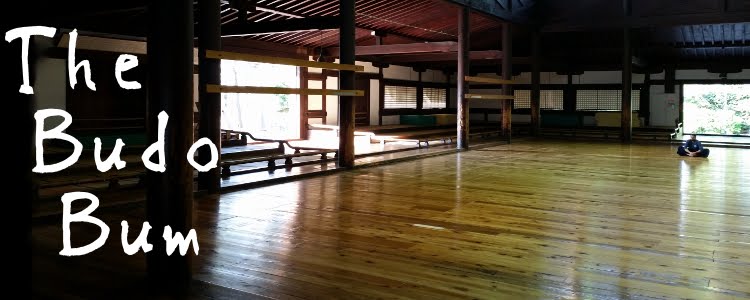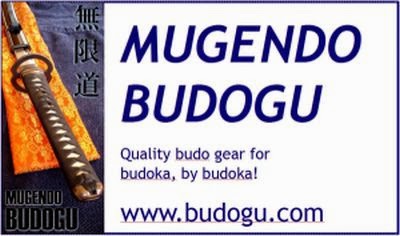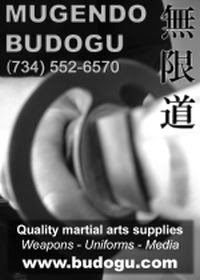A question came up in a budo group I’m part of asking what the 3 most important concepts in budo are. It’s an interesting question. What ideas are most fundamental in the art you practice? These concepts undergird and direct your training. They direct the focus of your training and what sort of things you are practicing. People offered quite a few ideas, including:
Keep your body relaxed.
Always keep your center (or be centered).
Keep your elbows down, and close to your body
Always try to control the first move
Many of the ideas offered were specific to Aikido, which is the point of that group. My thoughts are more general and apply to any form of budo. My list is structure/stance, spacing and timing, in that order. Each builds on where the previous concept is, and without effective use of the previous concept the next cannot be employed effectively. All apply regardless of whether you are doing kung fu, judo, boxing, aikido, swords, staves or scary stuff like kusarigama. This my list, and I make no claim that it is definitive. I offer it in the hope of sparking good conversation and consideration of the most important elements of practice and application. I’d thought to do these all in one post, but it looks like it’s I’m going to have to give each one it’s own post.
My first principle is structure/stance. Without a solid, connected, supported structure you can’t accomplish anything. This why I’m only partly joking when I say that the only thing I really teach is how to walk and how to breath. Good structure is what allows the fastest, most effective, stable and strong movement. If you are slouching and rolling your shoulders, tipping your head at the ground and not supporting yourself, you can’t breathe deeply or efficiently. Slouching and poor posture compress the torso so it cannot hold as much air. You will get tired more quickly just because you can’t get enough oxygen into your body fast enough.
Slouching also robs the body of it’s natural structural integrity. If you slouch, you’re off balance already. Judo folks stand or fall based on their balance, but this is true for anyone in any art. If you’re not balanced, you’re not stable in at least one direction.
In the picture above the two diagrams on the right show what our structure looks like when we slouch. Can you imagine trying to do any physical activity with that sort of compromised structure?
With good structure, loads and forces can easily be absorbed and handled, movement is quick, light and easy, and changes can be adapted to readily. Without it we can’t carry or absorb loads or force, movement is difficult, slow and tiring, and it is difficult to adapt to changes in the situation.
I’ve been showing this to my sword and jo students for years with a simple exercise. I let them hold a jo against my solar plexus whatever way they like holding the jo, and I can push the jo back into them and them across the room without any effort at all. They can’t do a thing to slow me down and I can reach them with a weapon or my hands before they can do anything about it. If the structure of the wrist is off it’s optimal angle even a little, it will collapse under pressure and be useless.
| With the structure of the wrist compromised like this (particularly clear in the left wrist) a push on the end of the jo will make the wrists collapse into the body and allow an attacker to easily drive in. |
On the other hand, if the wrist is at the proper angle, I can stick a 140 kg goon on the other end of the stick and he can’t push into me, or even into someone half my size. How can it be that just changing the angle of the wrist where you hold the stick can impact so much? I’ll let the mechanical engineers and the physics boys explain the details, because I don’t have a deep enough background there to do it anything like accurate justice.
| With properly aligned wrists, you can support far more than your own weight pressing into the end of the jo, and push from the hips with more energy than the arms can generate. |
This split between weak structural configurations and strong ones carries over to every joint in the body, and to the way the body as whole is arranged. If the wrist structure is good, but another joint such as the hip, knee or ankle is not aligned properly, the whole body structure is still weak and will collapse even if pressured only slightly.
Structure gives the body the ability to move, and when that structure is taken away, there isn’t much anyone can do. Over the weekend Howard Popkin impressed that upon me anew. He can, by simply moving around the force and structure of the body, completely undermine the power of people bigger and stronger than I am, and throw them casually, without so much as taking a deep breath. He simply maintained his structure and went around the lines of strength in mine.
You can push all you want on someone who keeps their structure aligned so your force is directed into the floor. It takes very little strength to maintain your structure under this kind of attack. The attacker’s force actually pushes your body to maintain good structure without the addition of much energy on your part. If you decide to push back, it’s actually easy to do because your structure is already supporting and negating their power. When you push back, they fly.
It’s interesting that according to Kano Jigoro, founder of Kodokan Judo, one of the two great secrets of great Judo is kuzushi 崩し. Kuzushi comes from a verb in Japanese that means tearing down, knocking down, breaking things into smaller parts. Sometimes it implies undermining and destroying a foundation. This is one of the great realizations of Kano’s that he put into his Judo. If you destroy the foundation of someone’s structure, take them off their foundation and remove the support from their structure, they become incredibly weak and a small woman can throw a large man.
This is true for whatever art you are practicing, whether it is armed or unarmed, jujutsu, karate, sword or chain, staff or rope. You maintain your posture and then you destroy your opponents.
The first step in mastering budo is learning to properly maintain your own structure. If you can’t do that, nothing else is possible. Once you’ve got that you have a powerful base to work from. Then you learn to manipulate and undermine your opponents structure. Once you destroy the integrity of their structure, throws and joint locks are easy. The key is that destroying the integrity of someone’s structure doesn’t involve harming them. It just means making them slump or slouch or come away from a balanced stance. Once you’ve done that, the actual technique isn’t terribly important because without a solid, balanced structure, it’s nearly impossible to defend oneself, even from a very poor attack.
Judoka spend an immense amount of time practicing off-balancing techniques to accomplish this. Aikido folks work on movements to draw someone out of good physical alignment. Daito Ryu folks work on doing it with the smallest movements possible. It all comes down to the same thing. Destroy the ability of the body’s structure to support it, and the person can’t resist anything.
There are the two sides of structure in budo. Create and maintain a solid, efficient, mobile structure in yourself while undermining your opponents structure and making it unable to support him and his movements. Mastery of structure is absolutely to everything we do in budo. We can’t begin to move and breath properly until we learn to do so with good structure. We can’t defend against anything without good structure. Effective attacks are impossible with an unstable structure.
Good structure is at the root of all good budo, whether it is a striking art, a grappling art, or a weapons art. Without good structure, you have nothing. That’s why it’s the first of my essential principles of budo.




